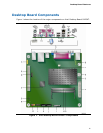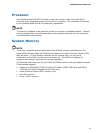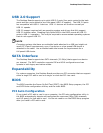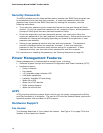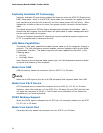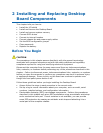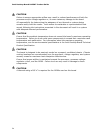
Desktop Board Features
17
USB 2.0 Support
The Desktop Board supports up to eight USB 2.0 ports (four ports routed to the back
panel and four ports routed to two front panel USB 2.0 headers). The USB 2.0 ports
are compatible with USB 1.1 devices. USB 1.1 devices will function normally at
USB 1.1 speeds.
USB 2.0 support requires both an operating system and drivers that fully support
USB 2.0 transfer rates. Disabling High-Speed USB in the BIOS reverts all USB 2.0
ports to USB 1.1 operation. This may be required to accommodate operating systems
that do not support USB 2.0.
NOTE
Computer systems that have an unshielded cable attached to a USB port might not
meet FCC Class B requirements, even if no device or a low-speed USB device is
attached to the cable. Use a shielded cable that meets the requirements for a
full-speed USB device.
SATA Interface
The Desktop Board supports two SATA channels (3.0 Gb/s) that support one device
per channel. The SATA controller supports IDE and ACHI configuration and can
operate in both legacy and native modes.
Expandability
For system expansion, the Desktop Board provides one PCI connector that can support
either a single PCI add-in card or a single- or dual-slot PCI riser card.
BIOS
The BIOS provides the Power-On Self-Test (POST), the BIOS Setup program, the PCI
and SATA auto-configuration utilities, and the video BIOS.
PCI Auto Configuration
If you install a PCI add-in card in your computer, the PCI auto-configuration utility in
the BIOS automatically detects and configures the resources (IRQs, DMA channels,
and I/O space) for that add-in card. You do not need to run the BIOS Setup program
after you install a PCI add-in card.





